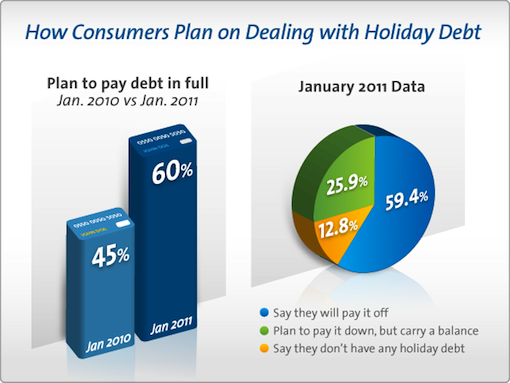In five short years we’ve gone from no borrower left behind, to no borrower left standing… and even those borrowers who somehow managed to claw their way back onto the train were often unceremoniously flung back off the trestle. It seemed that no one, except for a few dozen guys at Goldman Sachs, was safe.
While most financial reports are exhausting, terrifying and uncertain, the only thing we seem to be able to count on is that no one really knows what’s happening or what’s in store. But a just released Credit.com-GFK survey may portend a break in the storm clouds. No, it’s not increasing consumer confidence or decreasing foreclosure rates. Rather, we’re seeing signs that Americans are starting to take more responsibility for their financial well-being.
Our survey indicates that consumers are getting serious about getting out of debt. It finds that almost 60% of respondents say they intend to pay off holiday debt in full (up from 45% last year). Thirteen percent said they would try to pay down their debt but would still carry a balance, down from nearly 21 percent last year.

Stay tuned for more of our quarterly survey findings. Find out what consumers have to say about employer credit checks, marketing credit cards to teenagers, strategic default, online data privacy and more.
[Resource: Tips for Paying Off Credit Card Debt]
As far as I’m concerned, if this survey is indicative of a national trend, it’d be the best possible side effect of the economic mayhem we’ve been living through for the past few years. But I’m left wondering, is this a true transformation? Are Americans really getting serious about this stuff or are they just reacting to market forces? When the boom times return, and they always do, will Americans regress to a state of fiscal imprudence? That brings me to the three Fs.
What is responsible for this new found financial adulthood?
Were we forced to do it, because millions of accounts have been closed, limits lowered, or rates have been hiked to unconscionable levels?
Is it fear, brought on because friends, neighbors or family members have lost a job, suffered physical ramifications of financial stress, or experienced a significant loss of credit access?
Or, is it a renewed sense of frugality in light of all of the above.
At Credit.com we have always encouraged people to step up their financial literacy and to read every document received from every financial institution with which they do business. However, it’s no secret that in America that’s an uphill battle. Consumers traditionally have approached their bank and credit card statements like children at a horror movie – hands firmly placed in front of their eyes, every so often spreading a finger or two to see if the gory part was over. And it was a bloodbath.
Delinquencies exploded like cherry bombs on the Fourth of July, bankruptcies and foreclosures spread as swiftly as Patton’s 3rd Army rolled through Europe, millions of accounts were closed and credit limits were slashed – with little or no notice. Interest rates hiked to stratospheric levels. It was a fee for all – traditional fees begat strange sounding new fees that begat higher fees. Making minimum payments began to seem as plausible as middle-earth. It was by all accounts an era of irresponsible spending, borrowing and lending.
In 2008, however, things began to change. The financial crisis had hit, banks were in trouble and tightening up their lending standards and consumers were in even more trouble and as a result began tightening their belts too. By 2011, most banks that were too big to fail have repaid TARP, General Motors has done an IPO, the CARD Act and the Dodd-Frank Wall Street Reform and Consumer Protection Act are law, and on July 21 Elizabeth Warren’s Consumer Financial Protection Bureau becomes a living, breathing, regulatory reality. Welcome to the Age of Institutional Accountability people.
So how about personal accountability? If you ask me, regardless of which “F” is responsible for the improvements we’re seeing, it’s almost certain that they won’t last long if we don’t as a nation decide to make them permanent. That means building financial literacy into our educational system. I’ve written about this before, and you can be sure that I’ll write about it again. The reality of truly learning what it means to maintain a commitment to reduce debt, save more and spend less may turn Wal-mart’s J into a L, but in my humble opinion, it’s the requisite beginning of a more solid financial future for us all.
[Resource: Not sure where you stand credit wise? Get your Free Credit Report Card to find out.]
This national RDD Probability Sample telephone poll was conducted for Credit.com by GfK Custom Research North America from January 14-16, 2011. A total of 1,004 interviews were completed, with roughly 531 female adults and 473 male adults. The margin of error is +/- 3 percentage points for the full sample.
You Might Also Like
March 11, 2021
Personal Finance
March 1, 2021
Personal Finance
February 18, 2021
Personal Finance





